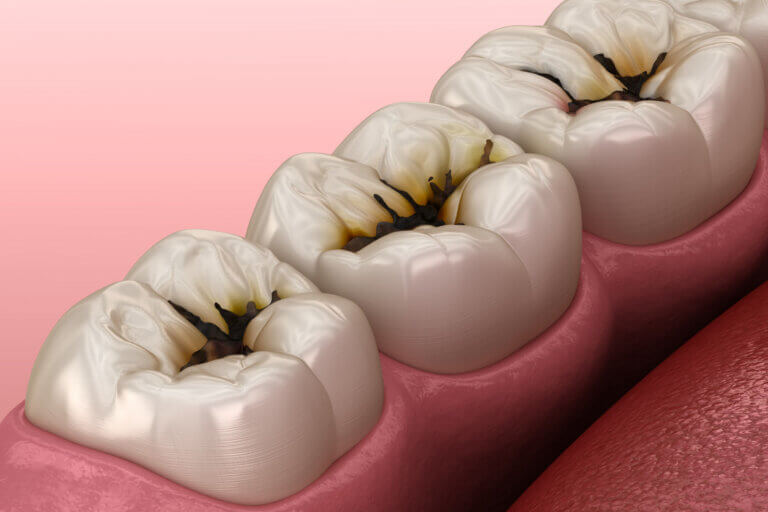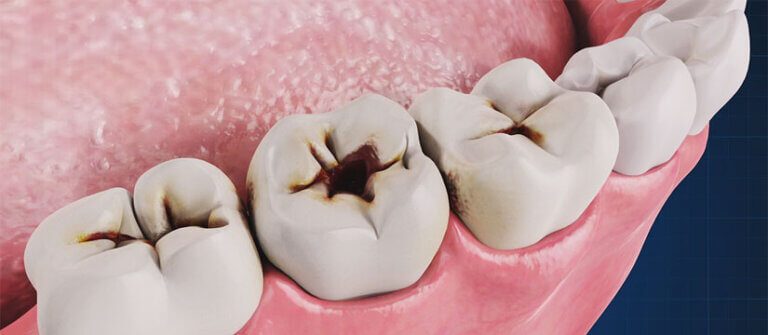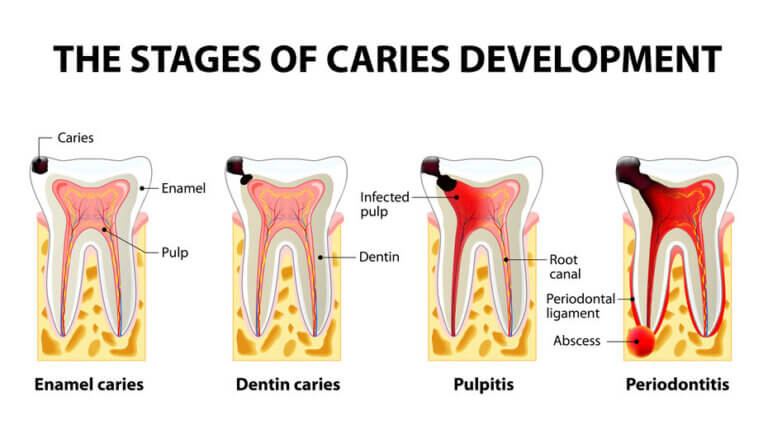Cavity

What Is A Cavity?
A Cavity, also known as dental caries, is a common dental problem that affects people of all ages. It is a small hole or a damaged area on the surface of a tooth that develops when the hard outer layer of the tooth, called the enamel, is weakened by acid produced by bacteria in the mouth. If left untreated, cavities can grow bigger and cause pain, infection, and even tooth loss.
The good news is that cavities can be prevented and treated with proper dental care. Before you contact a Toronto dentist to examine A Cavity, there are some things you should know as a patient:
- What Are The Types Of Dental Cavities?
- Why Do I Have A Cavity?
- Signs And Symptoms Of A Cavity
- Treatment Options For A Cavity
- How To Prevent A Cavity
- Managing A Cavity Until You Can See The Dentist
If you have questions about A Cavity or other dental problems, please contact us for more information.
What Are The Types Of Dental Cavities?
Types of tooth decay include:
- Pit and fissure decay: The top (occlusal) surface of posterior teeth have deep grooves, fissures and pits that can trap food particles, debris, and dental plaque more easily. This makes these surfaces more prone to dental decay due to the challenges in keeping them clean.
- Smooth surface: Smooth surface caries occur where there is no pit, groove, or other fault on a tooth. It occurs in areas where bacterial plaque collects, such as between teeth, along the gumline, and in difficult-to-clean areas.
- Root decay: Root caries occur on exposed tooth root surfaces close to the dental gum line. The root surface does not have a hard, protective enamel covering that is as thick and durable as the tooth enamel. This unprotected root structure is softer and more susceptible to dental decay. Older adults who have receding gums are more prone to root decay.

Why Do I Have A Cavity?
Cavities are caused by a combination of factors, including:
- Poor oral hygiene: Failing to brush and floss regularly can lead to the buildup of plaque, a sticky film of bacteria that produces acid and damages the tooth enamel.
- Sugary and acidic foods and drinks: Consuming foods and drinks high in sugar and acid can promote the growth of bacteria in the mouth and increase the risk of cavities.
- Dry mouth: A lack of saliva can make it difficult to neutralize acids in the mouth and wash away food particles and bacteria, increasing the risk of cavities.
- Genetics: Some people may be more prone to cavities due to their genetics, which can affect the strength of their tooth enamel and the composition of their saliva.
- Age: As we age, the tooth enamel can become weaker and thinner, increasing the risk of cavities.
- Eating disorders: Eating disorders such as anorexia and bulimia produce excessive stomach acids that will damage your teeth.
- Gastric reflux disease: This is a condition where there is too much regurgitated stomach acids that contribute to wearing down of tooth enamel.
- Previous radiation therapy: Radiation used to treat head and neck cancer can damage sensitive saliva-producing glands. Saliva is important for protecting against acids.
- Receding gums: putting you at an increased risk of root surface caries.
- Inadequate fluoride exposure: Fluoride has been found to strengthen and remineralize teeth, making them more resistant to cavities. Common sources of fluoride include fluoridated drinking water, fluoridated toothpastes and mouthwashes with fluoride in it.
It’s essential to understand these factors to prevent and manage cavities effectively. By taking steps to maintain good oral hygiene and avoiding sugary and acidic foods and drinks, you can significantly reduce your risk of developing cavities. If you have further questions about a Cavity, please contact us.
Signs And Symptoms Of A Cavity
Cavities may not always cause noticeable symptoms, especially in the early stages. However, some signs to watch out for include:
- Tooth sensitivity: If you experience discomfort or pain when eating or drinking hot, cold, sweet, or acidic foods or drinks, it may be a sign of a cavity.
- Toothache: A persistent toothache, especially when biting down, may indicate that a cavity has reached the inner layers of the tooth.
- Visible holes or pits on the tooth surface: As cavities progress, they can cause visible holes or pits on the surface of the affected tooth.
- Staining or discoloration: Cavities can cause white, brown, or black spots or stains on the tooth surface.
If you experience any of these symptoms, it’s essential to see a dentist as soon as possible. Early detection and treatment of cavities can prevent further damage to the tooth and reduce the need for more extensive and costly dental procedures in the future. If you have further questions about signs and symptoms of a Cavity, please contact us.
Treatment Options For A Cavity
The appropriate treatment for a cavity depends on the severity and location of the decay. Some common options include:
- Fillings: For small to moderate cavities, a dental filling may be recommended. The decayed portion of the tooth is removed, and the cavity is filled with a dental material such as amalgam, composite resin, or glass ionomer.
- Crowns: For larger cavities or decay that has destroyed a significant amount of natural tooth structure, a dental crown may be needed. The damaged portion of the tooth is removed, and a custom-made crown is placed over the remaining tooth structure.
- Root Canal Therapy: If the decay has spread to the tooth’s pulp or nerve, root canal treatment may be necessary. During this procedure, the infected tissue is removed, and the tooth is filled and sealed.
- Extraction: In severe cases where the decay has caused significant damage to the tooth, extraction may be necessary. Tooth replacement options include dental implants or dental bridges, or dentures.
It’s important to note that early detection and treatment of cavities can help prevent the need for more extensive and costly dental procedures in the future. If you have further questions about Cavity treatment options, please contact us.

How To Prevent A Cavity
Preventing cavities involves a combination of good oral hygiene practices and healthy lifestyle habits. Some tips to help prevent cavities include:
- Brushing twice a day: Brushing your teeth with fluoride toothpaste twice a day can help remove plaque and strengthen tooth enamel.
- Flossing daily: Flossing can help remove food particles and bacteria from between teeth and along the gum line.
- Limiting sugary and acidic foods and drinks: Reducing your intake of sugary and acidic foods and drinks can help minimize the growth of bacteria in the mouth.
- Drinking water: Drinking plenty of water can help wash away food particles and bacteria and promote saliva production, which can neutralize acids in the mouth.
- Using fluoride products: Using fluoride toothpaste and mouthwash can help strengthen tooth enamel and reduce the risk of cavities.
- Chewing sugar-free gum: Chewing sugar-free gum after meals can help stimulate saliva production and wash away food particles and bacteria.
By following these tips, you can significantly reduce your risk of developing cavities and maintain good oral health. It’s also important to schedule regular dental check-ups and cleanings to detect and treat any cavities early on. If you have further questions about how to prevent Cavities, please contact us.
Managing A Cavity Until You Can See The Dentist
If you suspect you have a cavity but can’t see a dentist immediately, there are some steps you can take to manage the symptoms and reduce the risk of further damage:
- Rinse with saltwater: Rinsing your mouth with warm saltwater can help reduce pain and swelling and prevent infection.
- Use over-the-counter pain relievers: Over-the-counter pain relievers such as Advil (ibuprofen) or Tylenol (acetaminophen) can help relieve pain and discomfort.
- Avoid hard, sticky, or sugary foods: These types of foods can worsen the cavity and cause further damage to the tooth.
- Apply a temporary filling: Over-the-counter temporary filling materials can help cover the cavity and provide temporary relief until you can see a dentist.
- Practice good oral hygiene: Brushing and flossing regularly and using fluoride products can help prevent the cavity from getting worse.
It’s important to note that these measures are only temporary and do not replace the need for professional dental treatment. If you have a cavity, it’s essential to see a dentist as soon as possible to prevent further damage and maintain good oral health. If you have further questions about managing Cavities, please contact us.

